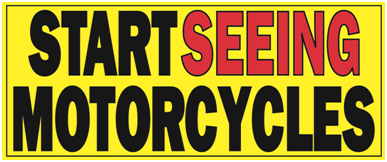The Twin Tiers motorcycle season has returned and we need to remember that safety has to be our No. 1 concern.
 We need to watch for the vehicles around us and not assume they can see us. We may think that because tractor-trailers have mirrors all over them that they can see well.
We need to watch for the vehicles around us and not assume they can see us. We may think that because tractor-trailers have mirrors all over them that they can see well.
But that is wrong. Every motorcycle in the photo above is invisible to the truck driver. He can’t see any of them. Think about that the next time you are near a tractor-trailer.
If you are going to pass one, get out and pass. Don’t hang around anywhere near them. You have to assume they can’t see you.
Here are “10 Things All Car And Truck Drivers Should Know About Motorcycles,” from the Motorcycle Safety Foundation. Please share this with the drivers in your life.
- Over half of all fatal motorcycle crashes involve another vehicle. Most of the time, the car or truck driver, not the motorcyclist, is at fault. There are a lot more cars and trucks than motorcycles on the road, and some drivers don’t “recognize” a motorcycle – they ignore it (usually unintentionally).
- Because of its narrow profile, a motorcycle can be easily hidden in a car’s blind spots (door/roof pillars) or masked by objects or backgrounds outside a car (bushes, fences, bridges, etc). Take an extra moment to look for motorcycles, whether you’re changing lanes or turning at intersections.
- Because of its small size, a motorcycle may look farther away than it is. It may also be difficult to judge a motorcycle’s speed. When checking traffic to turn at an intersection or into (or out of) a driveway, predict a motorcycle is closer than it looks.
- Motorcyclists often slow by downshifting or merely rolling off the throttle, thus not activating the brake light. Allow more following distance, say 3 or 4 seconds. At intersections, predict a motorcyclist may slow down without visual warning.
- Motorcyclists often adjust position within a lane to be seen more easily and to minimize the effects of road debris, passing vehicles, and wind. Understand that motorcyclists adjust lane position for a purpose, not to be reckless or show off or to allow you to share the lane with them.
- Turn signals on a motorcycle usually are not self-canceling, thus some riders (especially beginners) sometimes forget to turn them off after a turn or lane change. Make sure a motorcycle’s signal is for real.
- Maneuverability is one of a motorcycle’s better characteristics, especially at slower speeds and with good road conditions, but don’t expect a motorcyclist to always be able to dodge out of the way.
- Stopping distance for motorcycles is nearly the same as for cars, but slippery pavement makes stopping quickly difficult. Allow more following distance behind a motorcycle because you can’t always stop “on a dime.”
- When a motorcycle is in motion, see more than the motorcycle – see the person under the helmet, who could be your friend, neighbor, or relative.
- If a driver crashes into a motorcyclist, bicyclist, or pedestrian and causes serious injury, the driver would likely never forgive himself/herself.
Thanks for reading, and ride safely this year,
__________________________________________
ZiffLaw Attorney, Esq.
NY and PA Injury and Malpractice Attorney
The Ziff Law Firm, LLP
303 William Street
Elmira, NY 14901
Phone: (607)733-8866
Fax: (607)732-6062
Email: info@zifflaw.com


